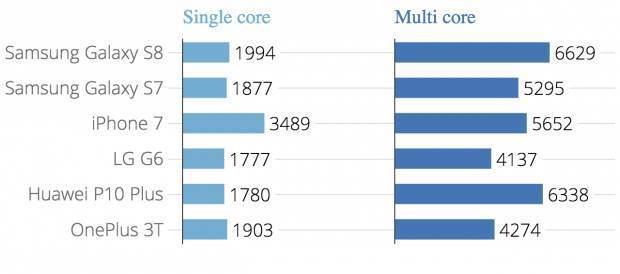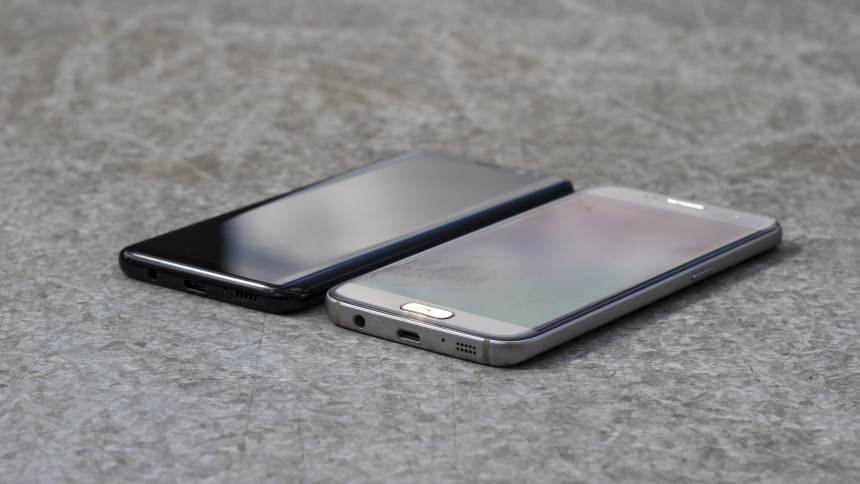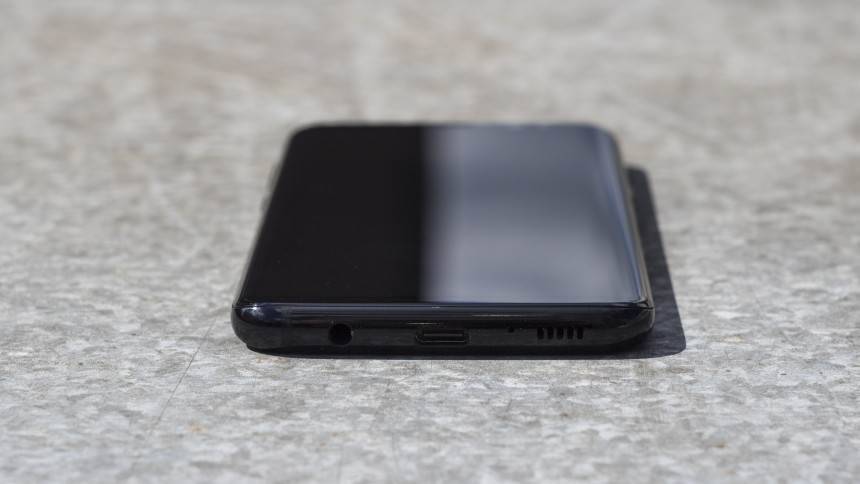The presumptive heir to the best Android crown is here: the Samsung Galaxy S8.
A few years ago, the race to be the world's favourite Android phone designer was wide-open. HTC would win it one year, and then LG would dazzle the next. Recently, the list has become more predictable: Samsung Galaxy S5, Samsung Galaxy S6, Samsung Galaxy S7.
Two things have changed to make this less a foregone conclusion than it was a couple of years ago, however. The first is that specifications have improved to the degree that even a cheap smartphone is good enough for most people. The second is the burnt out corpse of something that looks like it might have once been an elephant in the room: the Galaxy Note 7, removed from market after less than two months for being just a bit more flammable than advertised.
In short, we always knew that the Samsung Galaxy S8 was going to be good, but the stakes have been raised. It needs to be really good, and good enough to justify the enormous price tag too. Prices in Australia for pre-paid plans start at $80 a month on 24 month plans.
And it is good. Very good indeed. The best smartphone you can buy, bar none. Whether it's worth the cost though… that's strictly between you and your wallet, but hopefully the next few pages can at least help you justify the loan to your bank manager. Print this out if you think it'll help.
Design
Let me begin by saying that Samsung's teaser for the S8 was more than a little overblown. The video, released ahead of the phone's reveal last month, suggested something that would make you rethink what a phone looks like, and the Galaxy S8 doesn't really do that, unless you're terminally devoid of imagination. It's still a block of metal and glass; it's just a particularly beautiful one.
What the video alluded to is that the physical home button is gone. That's significant, but it isn't the first Android phone to do that; I distinctly remember my trusty HTC One M8 had no physical home button either. What is different is its dimensions: it's now quite a bit taller, and longer than its predecessors, making it extremely comfortable in the hand.
I use a Samsung Galaxy S7 as my main phone at the moment, itself a slim and attractive handset and the Galaxy S8 leaves it in the dust. Putting them side-by-side, the differences are obvious. It isn't not much bigger but it uses its space much more effectively with around 84 percent of the front occupied by the screen a not inconsequential upgrade on the S7's 72 percent. It's only three grams heavier, and is just 0.1mm thicker – which is odd, because if you put them next to each other a table, the Samsung Galaxy S8 looks substantially more svelte.
The phone inherits three design features from the previous generation: it's IP68 certified, which means it's waterproof in 1.5m of water for up to half an hour; it supports wireless Qi and PNA charging; and it has expandable storage for microSD cards up to 256GB in size should the 64GB of onboard storage prove insufficient. USB Type-C is in, which is better in the long run, but awkward if your house, like mine, has become a retirement home for micro USB cables.
There's even room for a 3.5mm headphone jack. Odd to think that's a controversial move, but Apple, HTC and Lenovo's recent decisions to remove it have made including the 60-year-old port a major selling point in a 2017 flagship.
There are just two issues you can legitimately have with the design. The first is that a whole button is dedicated to Bixby, Samsung's AI assistant, which at the time of writing doesn't do a great deal. For now, it's essentially a second home button, but the fact that Samsung has given it such prominence suggests it won't be forever, so you can give them a pass on that.
The second is harder to defend: the location of the fingerprint scanner. It's right next to the camera lens on the rear of the device, and while I was able to get used to this for unlocking over my time with the Galaxy S8, it was never as comfortable as one placed below the screen, as on the Samsung Galaxy S7 or Apple iPhone 7, or on the side of the device as with Sony's recent smartphones. Placing it right next to the camera lens also means you often find yourself touching the lens, rather than the scanner, so you'd best get used to giving it a good polish before you take a photo.
Screen
After you've finished gawking over the lovely design, the next thing you'll notice is that the screen looks a bit different to current phones: it's long and thin. While most phones work to a 16:9 aspect ratio, the S8 changes things up by increasing things to 18.5:9 with a resolution of 1440x2960. That's a slightly taller ratio than the LG G6 with its unusual 18:9 mix. The idea, according to Samsung, is that you can get more screen real estate in a handset that won't be uncomfortable for the small-pawed among us.
Of course, that's not exactly the case. A regular 16:9 5.8in handset has a greater area and, even if you like the newer tall design, it's not without its issues. For starters, most apps currently black out the bottom of the screen, leaving the familiar Android buttons in place. That means that the job could be done just as well by a bezel for the most part. The real advantage is for pictures and video, but there are issues there, too. 16:9 is the universal standard for video (notwithstanding the circle of Hell reserved for YouTubers who take video in portrait mode) and, if you watch any of those on your S8 you're going to have to decide between black bookends at each end, or cropping off the top and bottom of the screen.
Whether or not you think that's a sacrifice worth making for a stylish, comfortable handset like this will vary from person to person but you'll be unsurprised to hear that this AMOLED screen meets Samsung's usual standards of high quality. It reaches a pretty bright 415.16cd/m2 peak brightness on manual mode, and a searing 569cd/m2 in automatic in the right conditions. On top of that, it covers 99.9 percent of the sRGB spectrum. For comparison, here's how that looks against its key competitors:
|
Pixels per inch |
Peak brightness |
sRGB coverage |
Contrast |
|
|
Samsung Galaxy S8 |
570 |
415.16cd/m2 (manual); 569cd/m2 (auto) |
99.9% |
Perfect |
|
Samsung Galaxy S7 |
577 |
353.74cd/m2; (470cd/m2 auto) |
100% |
Perfect |
|
iPhone 7 |
326 |
540cd/m2 |
95.8% |
1425:1 |
|
LG G6 |
564 |
492.2cd/m2 |
93.2% |
1678:1 |
|
Huawei P10 Plus |
540 |
587.4cd/m2 |
98.5% |
Perfect |
|
OnePlus 3T |
401 |
421cd/m2 |
93.2% |
Perfect |
In other words, this is about as good a screen as you can get. It's considerably brighter than last year's model and closing in on the scores obtained by the IPS screens of the iPhone 7 and the recently released LG G6.
Performance
While the year-old S7 still pushes near the top of its class in terms of performance, it would be surprising if Samsung's latest didn't deliver a healthy performance boost on top of its cosmetic surgery. This isn't a Moto G5 situation: Samsung has indeed stepped up to the plate with newer components that deliver a healthy kick.
It shouldn't surprise anyone to learn that the Galaxy S8 feels incredibly fast and responsive out of the box. That's partly because no Android handset should feel sluggish from the first boot but also because Samsung has packed the latest technology into its thin frame. You're looking at a 2.3GHz octacore Exynos 8895 processor (or Qualcomm Snapdragon 835 for US-based customers), with 4GB RAM and 64GB storage, expandable via microSD card. It's among the first smartphones in the world to use a 10nm manufacturing process to produce the chip, which promises to improve efficiency and battery life as well as provide the best performance around.
That kind of technicality is hidden away from sight but what I can say with certainty is that the Samsung Galaxy S8 is super fast. Every benchmark revealed speeds at the very top of the class. In the Geekbench 4 multi-core test, it smashed past the iPhone 7 and LG G6, with only the Huawei P10 Plus coming close:

As for graphics performance, it was a similar story. The S8 is a powerhouse for mobile games:

To be clear, these graphical tests are intense, with cheaper handsets routinely getting single-figure frame per second scores. While most 2017 handsets should handle the majority of games on the marketplace, it's pretty clear that the S8 offers far more future-proofing than any other device we've seen to date.
Continues on page 2







_(21).jpg&h=142&w=230&c=1&s=1)


.png&h=142&w=230&c=1&s=1)




.jpg&w=100&c=1&s=0)










